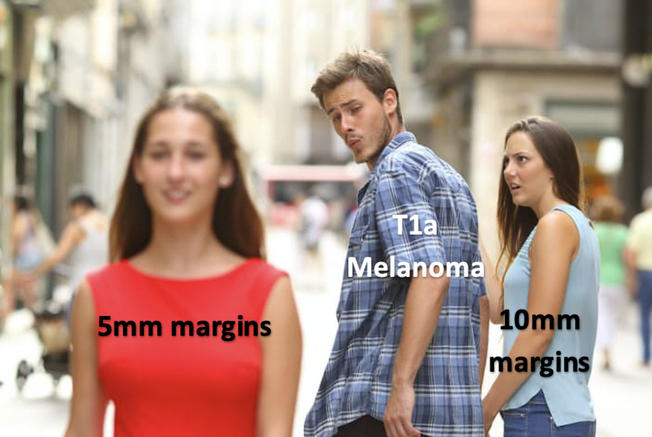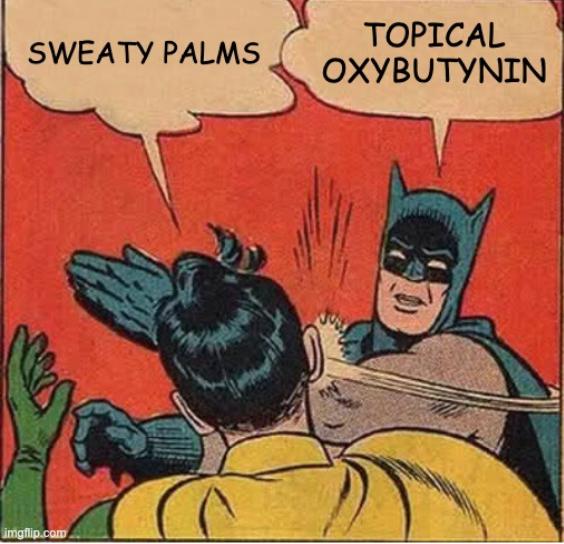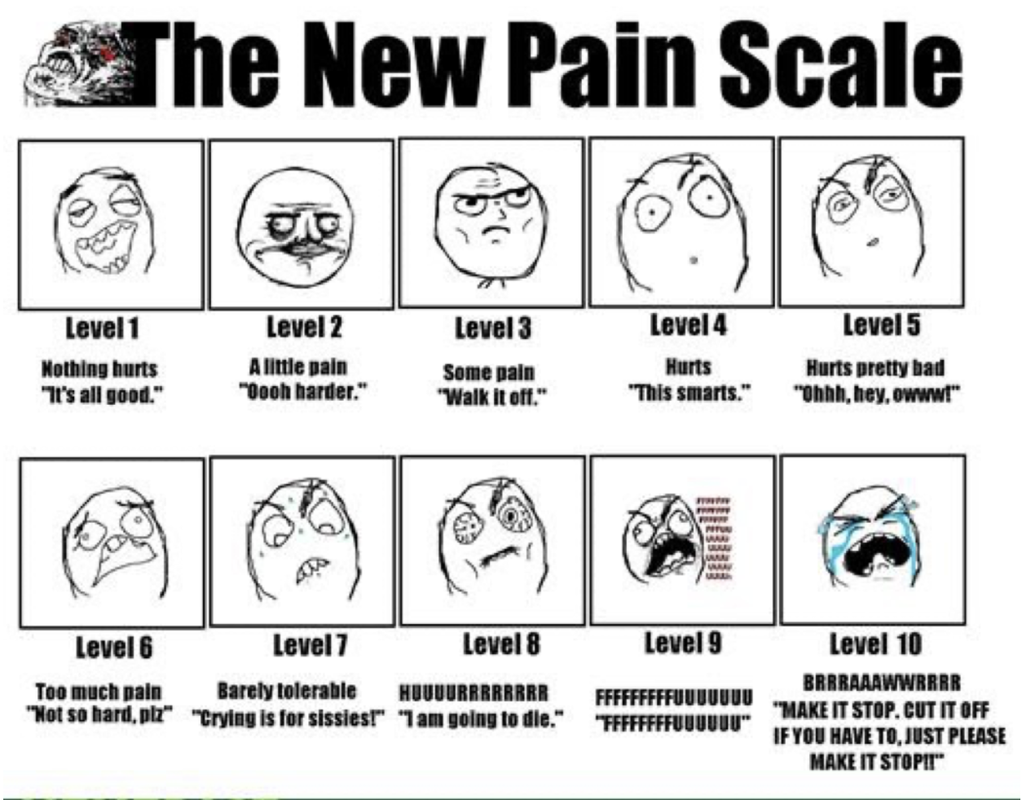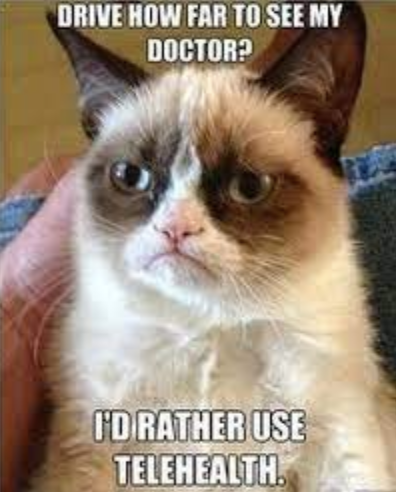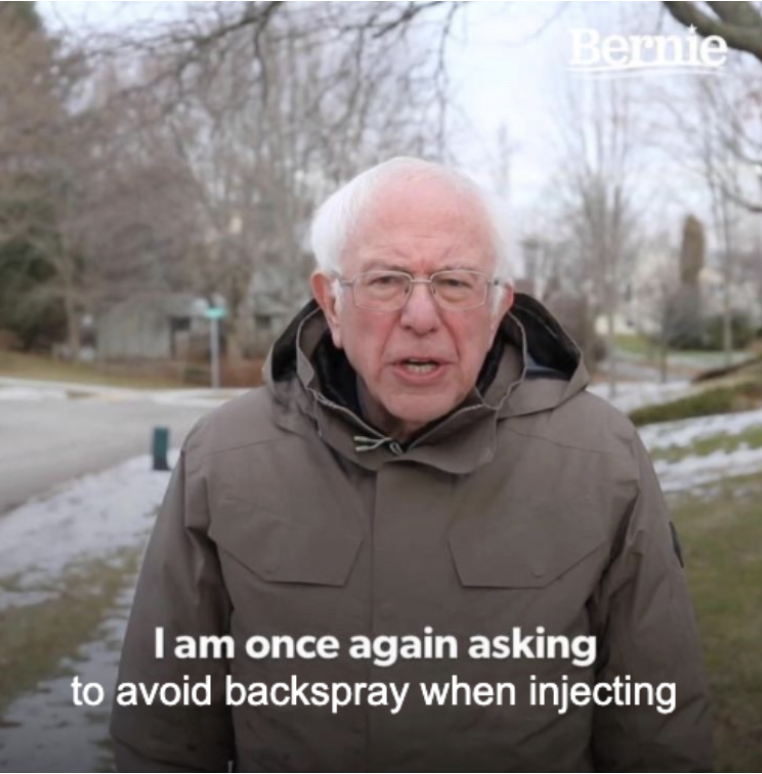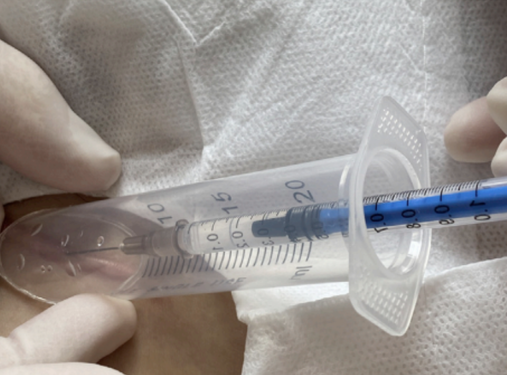THIRTY-Eighth ISSUE
july 12, 2023
Does decreasing margin size of T1a melanoma excision increase risk of recurrence and melanoma-specific mortality?
JAMA Dermatology
A smaller scar AND similar outcomes? Tell me more!
Wide local excision with a 10-mm margin is the standard treatment for T1a (Breslow depth <0.8mm) melanoma. Wide margins in sensitive areas including the face, scalp, genitalia, acral, periumbilical, and perineal areas can be challenging to perform and cosmetically displeasing for patients.
This retrospective cohort study of 1179 patients sought to compare rates of local recurrence and melanoma-specific mortality (MSM) in T1a melanomas excised with 5-mm (narrow) vs 10-mm (wide) margins. Researchers also compared the need for post-excision reconstructive surgery.
What did they find?
Main Takeaway: 5-mm margins may be adequate for T1a melanomas, and may result in fewer reconstructive surgeries. Those with Breslow thickness >0.4mm, acral melanoma, or lentigo maligna may not benefit from narrow excision.
Wide local excision with a 10-mm margin is the standard treatment for T1a (Breslow depth <0.8mm) melanoma. Wide margins in sensitive areas including the face, scalp, genitalia, acral, periumbilical, and perineal areas can be challenging to perform and cosmetically displeasing for patients.
This retrospective cohort study of 1179 patients sought to compare rates of local recurrence and melanoma-specific mortality (MSM) in T1a melanomas excised with 5-mm (narrow) vs 10-mm (wide) margins. Researchers also compared the need for post-excision reconstructive surgery.
What did they find?
- No significant differences were found in these outcomes:
- 10-year MSM was 1.8% (95% CI, 0.8%-4.2%) in the wide group, and 4.2% (95% CI, 2.2%-7.9%) in the narrow group
- 10-year local recurrence rate was 5.7% (95% CI, 3.9%-8.3%) in the wide margins group and 6.7% (95% CI, 4.7%-9.5%) in the narrow margins group
- 11.2% of narrow margin group vs. 30.7% of the wide-margin group required reconstructive surgery (p<0.001)
- Specific groups with worse outcomes:
- Breslow thickness greater than 0.4 mm and mitotic rate greater than 1/mm² were associated with worse MSM (p < 0.001)
- Acral lentiginous melanoma and lentigo maligna were associated with higher risk of recurrence overall.
Main Takeaway: 5-mm margins may be adequate for T1a melanomas, and may result in fewer reconstructive surgeries. Those with Breslow thickness >0.4mm, acral melanoma, or lentigo maligna may not benefit from narrow excision.
Sweat stopper: oxybutynin to the rescue!
Primary palmar hyperhidrosis (PPHH) is characterized by excessive and chronic sweating of the palms, and is thought to be caused by overactive sympathetic stimulation of eccrine sweat glands. Current treatments include topical aluminum chloride, iontophoresis, Botox injections, sympathectomy, and anticholinergics; each, however, has its own disadvantages. While topical oxybutynin has been used to treat primary focal hyperhidrosis, its specific efficacy for PPHH has not been explored.
This randomized, placebo-controlled, double-blind, phase III study (n = 284) sought to evaluate the efficacy of 20% oxybutynin hydrochloride lotion (OL) in reducing palmar sweat volume in patients with PPHH. Subjects applied 500 μL 20% OL to the surface of both palms once daily for 4 weeks; placebo was given to control subjects.
What did they find?
Main Takeaways: Topical 20% oxybutynin hydrochloride lotion may be an effective treatment option for patients with PPHH.
Primary palmar hyperhidrosis (PPHH) is characterized by excessive and chronic sweating of the palms, and is thought to be caused by overactive sympathetic stimulation of eccrine sweat glands. Current treatments include topical aluminum chloride, iontophoresis, Botox injections, sympathectomy, and anticholinergics; each, however, has its own disadvantages. While topical oxybutynin has been used to treat primary focal hyperhidrosis, its specific efficacy for PPHH has not been explored.
This randomized, placebo-controlled, double-blind, phase III study (n = 284) sought to evaluate the efficacy of 20% oxybutynin hydrochloride lotion (OL) in reducing palmar sweat volume in patients with PPHH. Subjects applied 500 μL 20% OL to the surface of both palms once daily for 4 weeks; placebo was given to control subjects.
What did they find?
- The responder rate (defined as reduction of sweat volume ≥ 50% from baseline) for sweat volume was significantly higher in the 20% OL group than the placebo group (52.8% vs 24.3%; difference: 28.5%; p < 0.001)
- Percent change in sweat volume significantly improved in the 20% OL group compared to placebo (48.6% vs 26.6%; difference: 22%; p < 0.001)
- Absolute change in sweat volume significantly improved in the 20% OL group compared to placebo (0.45 vs 0.23; difference: 0.22; p < 0.001)
- Improvement in Hyperhidrosis Disease Severity Score from baseline was significantly higher for the 20% OL group than placebo (≥1 point improvement, p = < 0.001; ≥2 point improvement, p = 0.006)
Main Takeaways: Topical 20% oxybutynin hydrochloride lotion may be an effective treatment option for patients with PPHH.
How do we measure pain in painful skin conditions?
British Journal of Dermatology
British Journal of Dermatology
How do you measure pain? In Hertz…
Pain is a frequently underrecognized and undertreated symptom of many skin diseases, such as herpes zoster, rheumatoid arthritis, hidradenitis suppurativa, and the list goes on. But the ways dermatologists measure and treat pain varies widely. In this systematic review, the authors examined clinical pain measurement techniques in randomized control trials of painful skin conditions.
What did they find?
Limitations: This is a systematic review of published literature on a variety of painful skin conditions. There are likely different pain patterns for specific diseases which should be addressed in future studies.
Main Takeaway: Pain is complicated! There is acute pain and chronic pain; there is nociceptive pain and neuropathic pain. There is a need for physicians to systematically evaluate and manage pain related to skin conditions.
Pain is a frequently underrecognized and undertreated symptom of many skin diseases, such as herpes zoster, rheumatoid arthritis, hidradenitis suppurativa, and the list goes on. But the ways dermatologists measure and treat pain varies widely. In this systematic review, the authors examined clinical pain measurement techniques in randomized control trials of painful skin conditions.
What did they find?
- Most studies (68%) utilized the numerical rating scale or the visual analog scale
- The majority of studies on painful skin conditions (77%) did not specify the time window of pain. The ones that did most frequently used a recall window of 24 hours
- Only 33% of studies on painful skin conditions asked about average pain level and the maximum pain level
Limitations: This is a systematic review of published literature on a variety of painful skin conditions. There are likely different pain patterns for specific diseases which should be addressed in future studies.
Main Takeaway: Pain is complicated! There is acute pain and chronic pain; there is nociceptive pain and neuropathic pain. There is a need for physicians to systematically evaluate and manage pain related to skin conditions.
Does speaking a non-English primary language impact telehealth utilization?
Pediatric Dermatology
Pediatric Dermatology
I would try telehealth, but I hear the camera adds ten pounds…
Teledermatology has become a useful tool to improve patient access and reduce the cost of care, particularly during the COVID-19 pandemic. Despite these benefits, there is growing concern that telehealth has become a “double-edged sword” that perpetuates health inequities due to technological, language, and other socioeconomic barriers. In this study, researchers conducted a retrospective review to evaluate the association between various socioeconomic factors, including primary language, and patient utilization of teledermatology in 3027 pediatric patients.
What did they find?
Teledermatology has become a useful tool to improve patient access and reduce the cost of care, particularly during the COVID-19 pandemic. Despite these benefits, there is growing concern that telehealth has become a “double-edged sword” that perpetuates health inequities due to technological, language, and other socioeconomic barriers. In this study, researchers conducted a retrospective review to evaluate the association between various socioeconomic factors, including primary language, and patient utilization of teledermatology in 3027 pediatric patients.
What did they find?
- 2331 pediatric patients who only had in-person encounters and 696 pediatric patients only seen by video-based synchronous teledermatology encounters were enrolled
- Non-English primary language patients were significantly less likely to utilize teledermatology compared to in-person services (12.1% vs 17.7%, p<0.001)
- Patients who utilized teledermatology were more likely to be older (10.255 vs 9.217 years, p<0.001) compared to those who only utilized in-person services
- There were no significant differences in geographic residence, ethnicity, race, or insurance type among patients seen only in-person vs those seen only via teledermatology
sk(in depth) scoop
Stay out of the splash zone!
Without the correct protective equipment, physicians are often caught in a crossfire of backspray from injections into lesions. Avoiding this spray can be critical in protecting the health of the physician and those assisting. How can backspray be avoided?
What did they find?
Without the correct protective equipment, physicians are often caught in a crossfire of backspray from injections into lesions. Avoiding this spray can be critical in protecting the health of the physician and those assisting. How can backspray be avoided?
What did they find?
- Use of a large volume syringe (i.e. 20 mL) as an encasing for a common barrel syringe can physically block backspray while injecting intralesionally
- The large volume syringe is cut via a heated disposable scalpel blade to remove the tip so that the common barrel syringe may be inserted
- A 60 degree slanting angle of the large volume syringe barrel allows for a larger surgical area to be covered, enhancing protection
Main Takeaway: Use of a cut large volume syringe to encase a common barrel syringe can protect physicians and those assisting from backspray of intralesional injections in settings of minimal protective equipment.

